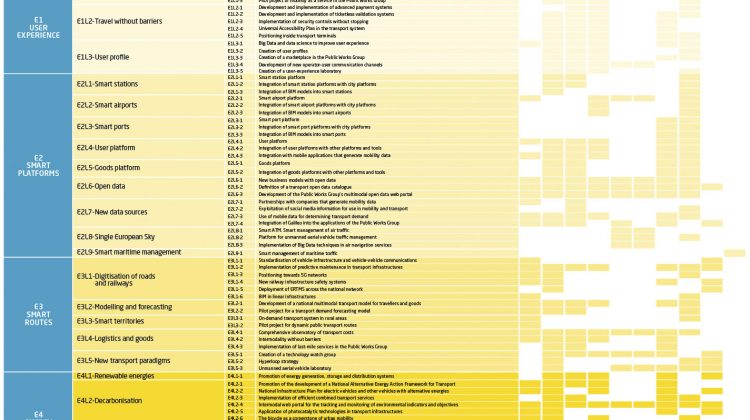Last November, Minister of Public Works, Íñigo de la Serna, presented the Transport and Infrastructure Innovation Plan 2017-2020, whose aim is to integrate and coordinate all of the innovation activities of the companies and institutions involved in the Public Works Group. With a planned investment of 50 million euros over a period of three years, the Plan starts in February 2018 with the launch of cross-cutting initiatives and projects throughout the Group so that ‘it will function as a collaborative group working within a network’, explained the minister.
Through the Plan, the Public Works Group is taking a major step forward in line with the European Commission’s H2020 programme, a financial instrument that seeks to ensure competitiveness through research and innovation. At the national level, the Plan is part of the government’s strategy on innovation, in which the Digital Agenda for Spain and the Spanish Strategy for Science, Technology and Innovation play particularly significant roles.
Thanks to the National Smart Cities Plan developed by the State Secretary for the Information Society and Digital Agenda (SESIAD) in collaboration with Ineco, Spain is a pioneer in the development of smart cities, having established a number of guidelines on platform interoperability that have become an international benchmark. The platform ecosystem proposed in the Innovation Plan follows these guidelines, ensuring that the different transport initiatives complement and can be integrated into the advances made in smart cities. The result is a common strategy based on a solid model.
The Transport and Infrastructure Innovation Plan also uses BIM (Building Information Modelling) as a cross-cutting element for all of the initiatives, given the strategic role that it needs to play in the future of Spanish innovation (see report).
A cutting-edge transport system
Transport plays a key role in the overall development of societies and their economies. The way in which people and goods move through an area largely defines its social, economic and environmental fabric, which is why actions in transport and infrastructure are a vital part of any basic strategy in the ongoing process of expansion and modernisation of societies.
For this reason, the Plan is committed to putting technology at the service of the citizen, using innovation to make advances in safety, accessibility and sustainability. These advances need to be accompanied by greater economic and social profitability through an increase in the efficiency and effectiveness of public and private investment.
The Innovation Plan is structured around four main dimensions to achieve these objectives: digitisation, Internet of the future, intermodality and energy transformation. Supported by these dimensions, the initiatives proposed in the Plan represent a great boost to the consolidation of a safer, more sustainable and accessible cutting-edge transport system, which will keep Spain at the forefront of innovation in transport.
The aim of the plan is to put technology at the service of the citizen, using innovation to make progress in safety, accessibility and sustainability, advances that need to be accompanied by greater economic and social profitability through an increase in effectiveness and efficiency in public and private investment
Four major cornerstones and 70 initiatives underway
Drafted by Ineco, the Innovation Plan included participation by the heads of Adif, Aena, ENAIRE, CRIDA, Spanish Port System and Renfe. The opinions of other institutions, such as the Spanish Rail Research Laboratory (CEDEX), Spanish Maritime Safety and Rescue Agency (SASEMAR), the Ministry of Public Works and various private entities, were also taken into account. Four strategic cornerstones have been identified in the Plan: user experience; smart platforms; smart routes; and energy efficiency and sustainability. These cornerstones are structured in turn into 22 strategic lines, which have materialised into 70 initiatives.
User Experience is aimed at personalising the offering according to user preferences, providing them with products and services on demand. To that end, the concept of ‘Mobility as a Service’ and, in general, public-private collaboration models will be promoted. Several other initiatives will focus on the elimination of barriers, with the development and implementation of new booking, payment and validation systems focused on cybersecurity and fraud reduction.
Big Data will be the technological foundation that will enable personalisation of services and improved user experience.
The second cornerstone, Smart Platforms, is designed as a cross-cutting element that provides technological support to all of the initiatives in the Innovation Plan. Through these Platforms, information is collected and processed by the companies in the Public Works Group, improving efficiency, quality and security of the services offered.
The proposed platform ecosystem covers all modes of transport and is integrated with city platforms. The application of the BIM methodology in stations, airports and ports, and the promotion of the Single European Sky will play a special role in this ecosystem, which will also consider the inclusion of unmanned aerial vehicles.
Smart Routes are aimed at the digitisation of roads and railways, with the development of a framework for the implementation of connected and autonomous vehicles. One of the fundamental aspects will be the standardisation and regulation of vehicle-vehicle and vehicle-infrastructure communications.
In addition, modelling and forecasting systems based on automatic learning and data science will be developed to enable smart transport planning and management. Dynamic traffic control, early recognition of congestion conditions on roads and dynamic driving management are some examples of the application of these developments.
The fourth cornerstone of the plan, Energy Efficiency and Sustainability, focuses on achieving transformation towards a sustainable and energy-efficient transport system in order to reduce greenhouse gas emissions, rationalise the use of fossil fuels and facilitate the switch to new transport solutions. This line includes initiatives that promote the use of renewable energy generation systems, use of surplus energy for self-consumption or feeding back into the grid, promotion of electric vehicles and other vehicles with alternative energies in transport networks, among others. All of these measures seek to adapt transport elements and direct them towards more sustainable and effective models in order to enable Spain to position itself as a benchmark in the international sector.
Facilitating open innovation and encouraging start-up entrepreneurship through synergies with companies in the Public Works Group is also part of the initiatives of this fourth cornerstone.
The Plan aims to set up an innovative network that integrates and connects all sectors of society, encouraging investment in innovation by large companies and SMEs and actively involving universities, technology centres and entrepreneurs. Within this line, the creation of an ‘Innovation Rail Hub’ seeks to launch collaborative R&D projects that promote railway technology on an international scale.

ILLUSTRATION_JAVIER JUBERA
Experts in public transport innovation
To draft the Plan, Ineco’s Department of Cooperation and Innovation collaborated with a team of experts in innovation from the companies and institutions in the Public Works Group. Adif, Aena, ENAIRE, CRIDA, Spanish Port System and Renfe, together with other institutions such as Cedex and SASEMAR, worked with Ineco on the drafting of a common project: “We set out a road map –says Rocío Viñas, Ineco’s deputy general director of Cooperation and Innovation– for the next three years with a strategy based on digitisation, the Internet of the future, intermodality and energy transformation.” For Rocío Viñas, analysis of the current situation of innovation projects “reflected the importance not only of sharing knowledge and creating synergies in the Public Works Group, but also of reinforcing collaboration with universities, startups and other companies, fostering and promoting our innovative culture inside and outside the EU.”
According to Javier Rodríguez Barea, Renfe’s manager of Transformation and Digital Innovation, the interesting aspect about this project is that “citizens are at the centre of the Innovation Plan, which acts a great prescriber of a new, more personalised, door-to-door mobility service in an interconnected and smart world, where technology and digitisation are put at the service of the companies in the Public Works Group in order to transform our value proposition towards society and improve user experience in our services.”
For Antonio Berrios, deputy director of Strategic Innovation at Adif, “one of the great contributions and challenges of this Innovation Plan is its cross-cutting vision within the Public Works Group, involving all companies making a technological leap to facilitate solutions that improve the capabilities of all of the modes of transport that travellers and goods units can use in their door-to-door mobility process.”
Along this same line, Juan Puertas Cabot, head of Aena’s Quality, Excellence and Innovation Division, adds that “effective innovation is always orientated towards known customers. The plan has combined the vision of the customer as a passenger on all modes of transport and as a citizen with their needs and expectations. This global vision is necessary to focus on effective innovation in global transport.” Juan Puertas points out that instead of highlighting a single initiative, he would stress the importance of including energy efficiency and sustainability as one of the main cornerstones: “It links with the whole strategy of the Plan, which puts society as a whole at the centre. I believe that a company of the future must necessarily be responsible and innovation is an essential tool to incorporate sustainability into transport processes.” In the case of Aena, within the framework of the Plan, the company is implementing the “digital transformation of the relationship with the passenger, where not only the necessary economic return is taken into account but also a focus on improvement of the passenger experience in the different steps of a customer’s journey at an airport. The firm commitment to this project has been reflected in 15 digital innovation initiatives that will be implemented during the next year.”
Thanks to ICT, transport services can be better designed and managed, addressing the real needs of citizens and interacting with them in real time and within an integrated and sustainable transport system that improves its economic and social profitability
Of the 70 initiatives, Jose Damián López, head of the Infrastructure Technology Department of the Spanish Port System, highlights the Intermodality without barriers (E3L4-2) initiative, because the project “will enable the planning and optimisation of services and infrastructures dedicated to intermodal transport, as well as simplifying administrative procedures through centralisation in the Goods Platform, providing one-stop services and monitoring the status of goods at the same time.” For José Damián López, the Plan also develops –in the field of R&D and innovation– the necessary relationships of trust between the companies in the Public Works Group, diversifying the risks and benefits associated with innovation, and increases “the value of expected results in all of the initiatives by adding to them the talent, knowledge and experience accumulated by the different organisations.”
Fernando Fernández Martín, head of ENAIRE’s European Convergence Division and responsible for the Innovation Plan, points out that it is difficult to choose from among the initiatives included in the Plan. While the Smart ATM initiative is key for ENAIRE (it addresses the evolution of the Spanish Air Traffic Management System to adapt it to the Single European Sky initiative), it would be unfair not to mention the Platform for the management of unmanned aerial vehicle traffic, because it faces the challenge posed by the arrival of unmanned aerial vehicles in our environment, on the one hand to encourage the development of new business models, while preventing this type of vehicle from posing risks for manned aircraft or citizens.
For José Miguel de Pablo, director of CRIDA(1), the Ministry’s Innovation Plan “will enable the promotion and consolidation of the incipient implementation of Big Data techniques at the service of ENAIRE, therefore, improving the efficiency of aerial navigation services. The computing power that is currently available and the increasing degree of maturity of technologies such as Artificial Intelligence, Big Data and Machine Learning offer an alternative to the use of conventional techniques, allowing them to overcome their limitations.” The Plan, he adds, “opens up a new horizon of possibilities that can range from improvements in available information and reliability and streamlining of decision making to the automation of processes through the development of intelligent predictive models. And all with one sole purpose: to improve the service provided to the passenger.”
(1) CRIDA is the ATM R&D+innovation Reference Centre, A.I.E. formed by ENAIRE, (66.66%), Ineco (16.67%) and the Polytechnic University of Madrid (16.67 %).







